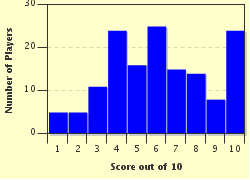Quiz Answer Key and Fun Facts
1. Saul of Tarsus, who became known as Paul the Apostle, although not one of the twelve disciples taught the gospel of Christ during the 1st century. He was executed in Rome around the year 64, during the reign of which Emperor?
2. Treason is a common reason for execution. Thomas Cranmer, a 16th century Archbishop of Canterbury and compiler of the first and second versions of the "Book of Common Prayer" was executed for 'treason and heresy' under the reign of which monarch?
3. "Guy Fawkes Day" has been celebrated annually in England since 1605, in commemoration of a plot to blow up Parliament and assassinate King James I. Although it is Fawkes who is best remembered from the group of Catholics, who was their leader?
4. Royalty is, of course, not exempt from execution, as the French discovered at the end of the 18th century. Earlier than that, though, King Charles I lost his head on the executioner's block. In which year did that happen?
5. Beheading was a popular method of execution in England during the Middle Ages, and the trend spread south across the Channel to France, although here it was the the guillotine that did the deed rather than a human axeman. One of the best-known of the 40,000 or so who died this way during the French Revolution was Marie Antoinette, but in which country was she born?
6. Moving forward into the 19th century, we find that even this recently things are very different than they are today. John Smith and James Pratt were the last people in England to to be executed for what crime?
7. You might have thought that prosecutions for "War Crimes" and "Crimes Against Humanity" was a recent innovation, but perhaps the first such case involved Henry Wirz as long ago as 1865. As the commander of a prison-of-war camp, he was tried and executed for atrocities committed under his command during which conflict?
8. One of the most famous espionage trials was surely that against the only two American civilians executed for spying during the Cold War, husband and wife Julius and Ethel Rosenberg. At which prison were they executed?
9. Samuel K Doe, who was tortured and executed by rebels in 1990, was the President of which African country throughout the 1980s?
10. Ten prominent members of the Nazi Germany leadership were executed by hanging following the Nuremberg Trials of 1945-46. Which of these was NOT one of those ten?
Source: Author
EnglishJedi
This quiz was reviewed by FunTrivia editor
bloomsby before going online.
Any errors found in FunTrivia content are routinely corrected through our feedback system.

